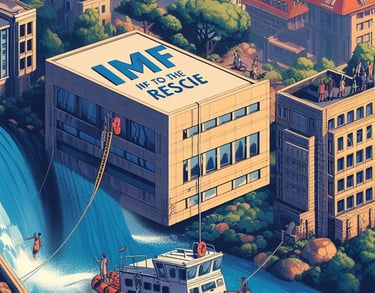
IMF to the Rescue: A Financial Lifeline for Kenya
In the world of finance, it’s not every day that you hear about a rescue mission. But when you do, it’s usually a big deal. And this time, it’s the International Monetary Fund (IMF) swooping in to save the day for Kenya. Here's everything you need to know
BUSINESS AND INVESTMENTKENYA NEWS
Mohamed Sabir Aamir Malik
11/22/20232 min read


The Crisis
Kenya was on the brink of a financial crisis, teetering on the edge of a precipice with a Sh300bn Eurobond scare. It was like watching a suspenseful movie where the hero is hanging off a cliff by their fingertips. But just when you think all hope is lost, in comes the IMF, like a superhero in a business suit.
The Rescue
The IMF has approved an additional Sh142.6 billion. This move is set to prevent Kenya from plunging into a financial crisis. It’s like a financial defibrillator, jolting the economy back to life. The first tranche of Sh103.8 billion will be released in January.
The Impact
This funding boost is expected to support Kenya’s economic recovery. It’s like a shot of adrenaline, giving the economy the strength it needs to get back on its feet.
But what does this mean for businesses and hustlers in Kenya? Here’s the breakdown:
Stabilizing the Economy: The funding helps stabilize the economy, which is beneficial for businesses as it creates a more predictable and stable business environment.
Boosting Investor Confidence: The IMF’s support can boost investor confidence in the country’s economy. This can lead to increased foreign investments, providing businesses with more opportunities for growth.
Government Spending: The funds can enable the government to maintain or increase its spending on public services and infrastructure. This can lead to contracts for businesses and job opportunities for individuals.
Lowering Interest Rates: The funding can help lower interest rates, making it cheaper for businesses and individuals to borrow money. This can stimulate investment and consumption, leading to economic growth.
However, it’s important to note that while these are generally expected outcomes, the actual impact can vary based on a multitude of factors, including the government’s fiscal policies and economic conditions.
Regarding government spending, the IMF funding is expected to help Kenya respond to drought and food security needs by partially offsetting the shortfalls in external financing. This suggests that the funds could be used for public services and infrastructure, which could potentially lead to contracts for businesses and job opportunities for individuals.
As for interest rates, it appears there has been an increase in some lending rates in Kenya. Some banks raised the base lending rate for their Kenya shilling-denominated loans to 11 per cent from 10 per cent and their dollar-denominated loans to 10 per cent from 9 per cent. This increase in interest rates could be due to various factors, including changes in monetary policy, inflation, or risk perceptions among lenders.
It’s important to note that while IMF funding can provide a financial lifeline, it doesn’t automatically solve all economic challenges. The effectiveness of these funds largely depends on how they are managed and utilized. Therefore, close monitoring and prudent fiscal management are crucial to ensure that these funds are used effectively and for the intended purposes.
Conclusion
In conclusion, while the IMF funding has the potential to bring about positive changes, the actual outcomes will depend on a variety of factors, including the actions of the Kenyan government and prevailing economic conditions. It’s a complex issue with no easy answers, but one thing is clear: the conversation around it is far from over.



